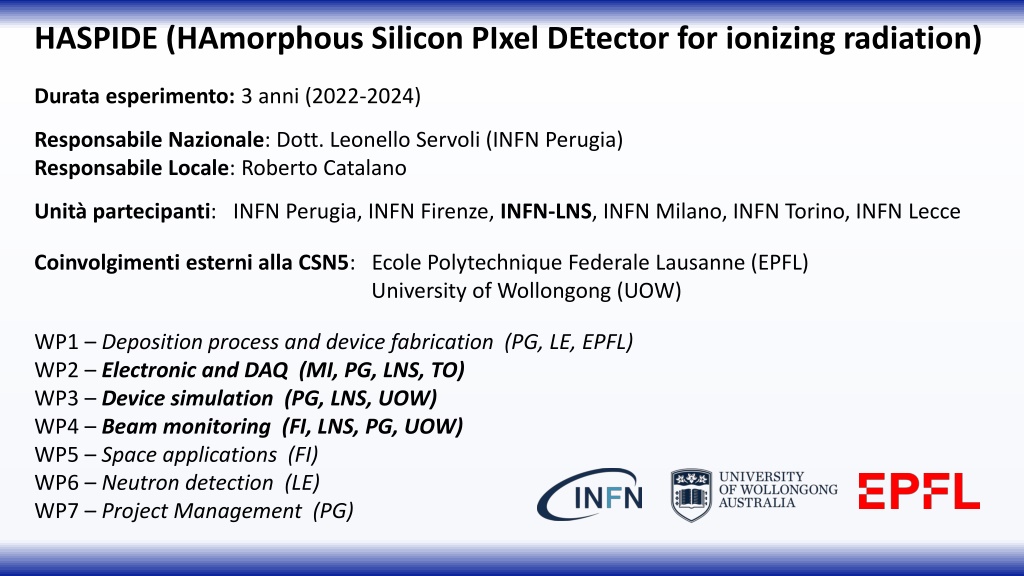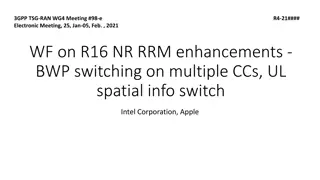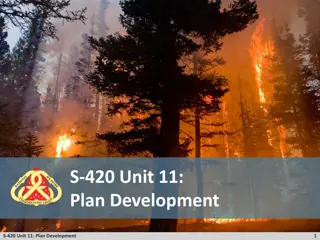
HASPIDE Project: Ionizing Radiation Detection using Si-H
Explore the HASPIDE project utilizing Si-H for ionizing radiation detection of various types in different regimes, aiming at accurate measurement and dosimetry, cosmic radiation detection, and neutron detection. Preliminary studies have been conducted exposing non-optimized structures to photon beams and electron clinical beams.
Uploaded on | 0 Views
Download Presentation

Please find below an Image/Link to download the presentation.
The content on the website is provided AS IS for your information and personal use only. It may not be sold, licensed, or shared on other websites without obtaining consent from the author. If you encounter any issues during the download, it is possible that the publisher has removed the file from their server.
You are allowed to download the files provided on this website for personal or commercial use, subject to the condition that they are used lawfully. All files are the property of their respective owners.
The content on the website is provided AS IS for your information and personal use only. It may not be sold, licensed, or shared on other websites without obtaining consent from the author.
E N D
Presentation Transcript
HASPIDE (HAmorphous Silicon PIxel DEtector for ionizing radiation) Durata esperimento: 3 anni (2022-2024) Responsabile Nazionale: Dott. Leonello Servoli (INFN Perugia) Responsabile Locale: Roberto Catalano Unit partecipanti: INFN Perugia, INFN Firenze, INFN-LNS, INFN Milano, INFN Torino, INFN Lecce Coinvolgimenti esterni alla CSN5: Ecole Polytechnique Federale Lausanne (EPFL) University of Wollongong (UOW) WP1 Deposition process and device fabrication (PG, LE, EPFL) WP2 Electronic and DAQ (MI, PG, LNS, TO) WP3 Device simulation (PG, LNS, UOW) WP4 Beam monitoring (FI, LNS, PG, UOW) WP5 Space applications (FI) WP6 Neutron detection (LE) WP7 Project Management (PG)
Aims The HASPIDE project wants to explore the possibility to use a:Si-H as a detection material for ioni- zing radiation of different types (photons, electrons, protons, ions, neutrons). Two detection regimes should be tackled: the continuous or pulsed intense radiation flux (e.g., FLASH-RT); the pulse-by-pulse mode, typical of space applications or neutron detection. The material in itself is very radiation-resistant, could be deposited as a thin layer of few micro- meters over many substrates, including flexible ones like Kapton, that potentially opens the way toward many important applications: ionizing radiation flux measurement and dosimetry of charged and photon beams, both clinical and non-clinical ones (accuracy 2% without perturbing the incoming radiation beam); detection of cosmic radiation in the spatial environment; neutron detection after deposition of a thin 10B converter layer.
Methods Some preliminary studies exposing some non-optimized structures either to photon beams, both clinical and laboratory X-rays, and electron clinical beams have already carried out. 50 kVp X-ray tube (0V bias) 6MV photon beam (0V bias) Similar results hold for 6 MeV electrons.
Requests Consumo Nome FTE Cirrone Giuseppe A. Pablo 0.2 Cuttone Giacomo 0.1 Inventario Falciglia Pietro Paolo 0.3 Milluzzo Giuliana 0.2 Missioni Patti Iolanda Valeria 0.2 Raffaele Luigi 0.2 Personale Assegno di ricerca (1 anno) 24 k Totale 1.2 Totale 24 k






















